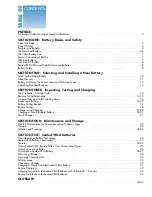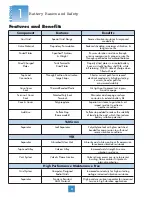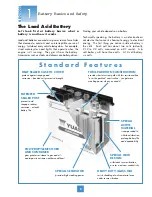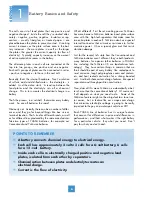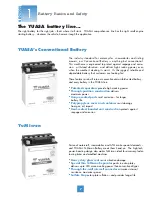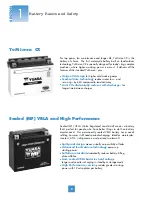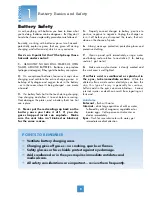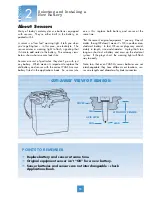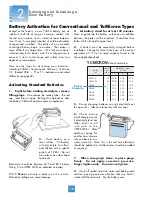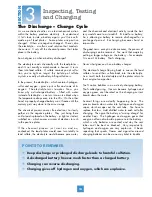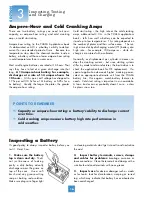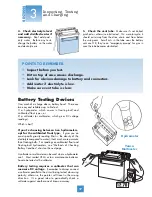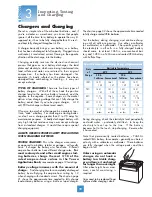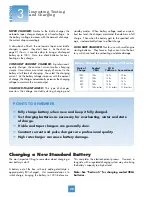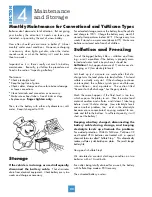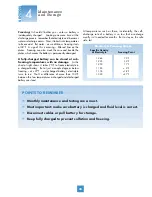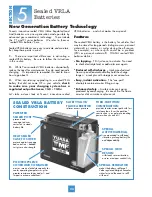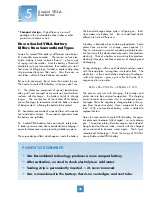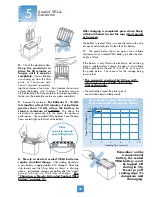
As we mentioned earlier, an electrochemical action
within the battery produces electricity. To understand
it, let’s look inside a battery again: you’ll see cells
made up of lead plates. Some plates are positive
charged. Others are negative charged. There’s also
the electrolyte – a sulfuric acid solution that conducts
the current. It sets off the chemical process that takes
place in the battery.
So what goes on when a battery discharges?
The electrolyte reacts chemically with the lead plates –
and it’s not exactly a match made in heaven: it turns
them into lead sulfate. If sulfate reminds you of sulfa-
tion, you’re right on target: this build-up of sulfate
crystals is exactly what battery-killing sulfation is.
In the process, the electrolyte – which contains hydrogen,
sulfur and oxygen – gives up its sulfur and some of its
oxygen. The electrolyte turns to water. Now you
know why a discharged battery – filled with water
instead of electrolyte – can turn into an ice block when
the temperature drops even into the 20s. On the other
hand, a properly-charged battery won’t freeze until the
mercury gets way down in the minus range.
The chemical process causes free electrons to slowly
gather on the negative plates. They just hang there
until a load is placed on the battery – a light or starter’s
switched on – which causes a swarm of electrons to rush
to the positive plates.
If the chemical process just went on and on,
unchecked, the lead plates would soon turn totally to
lead sulfate, the electrolyte would become pure water,
and the chemical and electrical activity inside the bat-
tery would come to a standstill. It’s bad for a battery.
So is allowing a battery to remain discharged for a
prolonged period. Recharging becomes hard or
impossible.
The good news: except in extreme cases, the process of
discharging can be reversed. You work that magic by
putting a larger voltage on the battery – for example,
14v on a 12v battery. That’s charging.
Here’s what goes on when a battery charges:
The electrical charge flowing back in causes the lead
sulfates to send their sulfate back into the electrolyte.
As a result, both the electrolyte and the plates return to
their original composition.
You’ll notice bubbles in an actively-charging battery.
That’s called gassing. It occurs because hydrogen and
oxygen gases are liberated as the charging current
breaks down the water.
Several things are actually happening here. The
process breaks down water into hydrogen and oxygen
vapor, which escapes out the vent tube. You have to
replace that loss. Add distilled water to each cell after
charging. Then give the battery a “mixing charge” for
another hour. The hydrogen and oxygen gases that
are given off can also build up pressure in the battery –
which is why batteries are vented, and why the vent
tubes can’t be bent or blocked. Very importantly,
hydrogen and oxygen are very explosive. It bears
repeating that sparks, flames and cigarettes around
charging batteries can be a one-way ticket to trouble.
POINTS TO REMEMBER
❐
Deep discharge or prolonged discharge leads to harmful sulfation.
❐
A discharged battery freezes much faster than a charged battery.
❐
Charging can reverse discharging.
❐
Charging gives off hydrogen and oxygen, which are explosive.
The Discharge – Charge Cycle
13
3
SECTION
Inspecting, Testing
and Charging
Summary of Contents for SmartShot Automatic 12V 1.5 Amp 5 Stage
Page 1: ......



